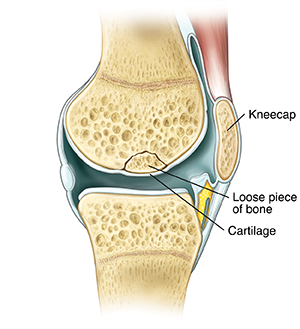When Your Child Has Osteochondritis Dissecans
Your child has been diagnosed with osteochondritis dissecans (OCD). This is when a small piece of bone and cartilage in a part of a joint separates from the bone around it. OCD is most common in the knee joint, but it can happen in other joints such as the elbow and ankle. The condition can be mild, moderate, or severe.
 |
| When a child has OCD, bone and cartilage break loose from the knee joint. |
-
Mild OCD. A piece of bone has begun to separate from the joint, but this piece is still firmly held in place by a covering of cartilage (dense elastic tissue that helps cushion the joint).
-
Moderate OCD. The piece of bone separates more. The covering of cartilage may tear.
-
Severe OCD. The piece of bone and covering of cartilage become loose and “float around” in the joint.
Your child may see an orthopedist. This is a doctor who treats bone and joint problems. They will evaluate and treat your child's joint.
What are the causes of osteochondritis dissecans?
Experts don't know exactly why some children develop OCD. They do know these things:
-
The separation of bone from the joint may be due to loss of blood supply to that piece of bone.
-
Overuse of the joint and repeated stress (from jumping or running, for example) make a child more likely to develop OCD.
-
Children who are athletes develop OCD more often than non-athletes.
-
OCD is most common in boys between the ages of 10 to 16.
-
OCD may run in families.
What are the signs and symptoms of osteochondritis dissecans?
Common signs and symptoms of OCD include:
-
Joint soreness
-
Joint swelling that can sometimes come and go
-
Pain when the joint is used, but children sometimes have trouble identifying where the pain is
-
Stiffness of the joint when it’s not being used
-
Feeling that the joint is “locking up” or “catching”
-
Limping (if the knee or ankle is affected)
How is osteochondritis dissecans diagnosed?
The doctor will ask about your child’s health history and symptoms. If they think your child has OCD, an X-ray will be done. In some cases, a test called an MRI (magnetic resonance imaging) may also be done. During this test, strong magnets and radio waves are used to create a picture of the inside of the joint.
How is osteochondritis dissecans treated?
The goal of treatment for OCD is to heal the joint. The separated piece of bone and cartilage need to heal back onto the joint. This healing takes time, often up to 6 months. During this time:
In severe cases, the doctor may advise surgery. During surgery, a pin may be put into the loose piece of bone to secure it to the rest of the joint. Or, the loose piece of bone is removed. After surgery, your child will use crutches for 1 to 3 months to allow the joint to heal.
What are long-term concerns?
With treatment, OCD often heals well. If the lesion doesn’t heal, your child may develop joint pain that doesn’t go away. An adult who had OCD as a child may be more likely to develop arthritis. Your child’s doctor can tell you more about this.
Online Medical Reviewer:
L Renee Watson MSN RN
Online Medical Reviewer:
Raymond Turley Jr PA-C
Online Medical Reviewer:
Thomas N Joseph MD
Date Last Reviewed:
1/1/2022
© 2000-2024 The StayWell Company, LLC. All rights reserved. This information is not intended as a substitute for professional medical care. Always follow your healthcare professional's instructions.